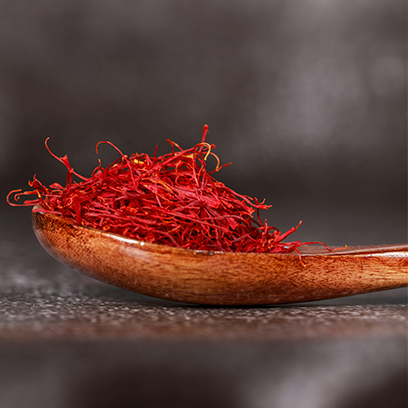SAFFRON
Saffron, for many decades the most expensive spice in the world, originated in the Middle East, although it was apparently first cultivated by the ancient Minoan civilisation in the Greek provinces (Crete, Aegean Sea) and is believed to have been introduced to Europe by the Knights Templar. The largest producer of saffron is Iran, but Spain, Afghanistan and India are also notable exporters of this prized spice. Moroccan saffron is particularly known for its healing properties.Saffron is known for its bitter taste and intense aroma attributed to picrocrocin and safranal. It contains crocin, a carotenoid which imparts a golden-yellow hue to dishes containing saffron, making it a prized ingredient in numerous culinary specialities worldwide, particularly in Persian cuisine.The high price of saffron is due to the difficulty of extracting it, a process which is carried out manually. Harvesting the tiny dark stigmas responsible for its distinctive colour and unique aroma is an extremely delicate process. It takes about 75,000 flowers and about 200 hours of intense labour to produce half a kilo of saffron. In Kashmir, India, thousands of cultivators must work continuously for days on end to prevent the saffron flowers from wilting and petals from adhering to the stigmas, which would render them unusable.
The benefits of saffron for eye health have been recognised since ancient times. The Egyptian Ebers papyrus, the oldest known medical text, mentions saffron as a remedy for treating eye disorders. In traditional Iranian medicine, saffron is renowned for its ability to strengthen eyesight.
Saffron improves visual acuity in adults with age-related macular degeneration (AMD) and shields against damage caused by free radicals found in retinal conditions. Saffron also alleviates ocular hypertension, a key factor in glaucoma. The antioxidant and hypotensive powers of saffron are mainly attributed to crocin.
Clinical evidence from studies has shown the benefits of saffron for vision. Oral supplementation with saffron stigma extracts at a daily dose of 20 mg, has been shown to improve retinal sensitivity in individuals with AMD, demonstrating long-term effects. At a daily dose of 30 mg, saffron also provides ocular hypotensive effects in individuals with glaucoma. Participants in the study reported an improvement in the quality of their vision quality, particularly in contrast and colour perception.
Used in: Pinelli Glau Project®
READ SCIENTIFIC PUBLICATIONS ON SAFFRON:
- Ocular hypothensiive effect of saffron on open.angle glaucoma
- Plants Used as Antihypertensive
- Saffron (Crocus sativus L.) in Ocular Diseases: A Narrative Review of the Existing Evidence from Clinical Studies
- Searching for the Antioxidant, Anti-Inflammatory, and Neuroprotective Potential of Natural Food and Nutritional Supplements for Ocular Health in the Mediterranean Population
- The pharmacological activity of Crocus sativus
- Treatment of glaucoma and its mechanism of action. An update
- A study into the effectiveness of the application of saffron extract in ocular
- Beneficial effects of saffron (Crocus sativus L.) in ocular pathologies, particularly neurodegenerative retinal diseases
- Crocetin a carotenoid derivative, inhibits retinal ischemic damage in mice
- Crocetin confers neuroprotection and is anti-inflammatory in rats with induced glaucoma
- Crocetin, a carotenoid derivative, inhibits retinal ischemic damage in mice – ScienceDirect
- Crocin as a vision supplement – PubMed
- Effects of Crocin Analogs on Ocular Blood Flow and Retinal Function
- Neuroprotective and anti-inflammatory effects of saffron in a glaucoma model
- Nutritional supplementation in the prevention and treatment of glaucoma

